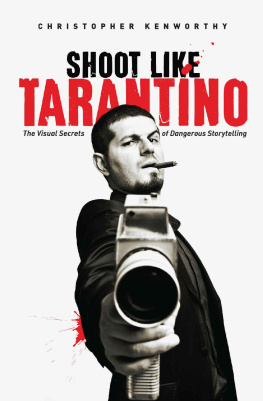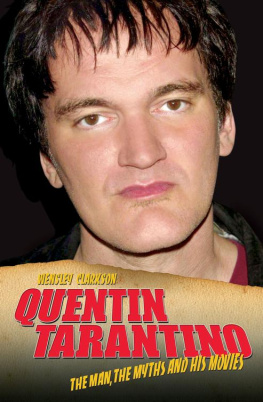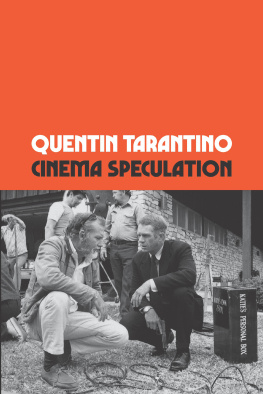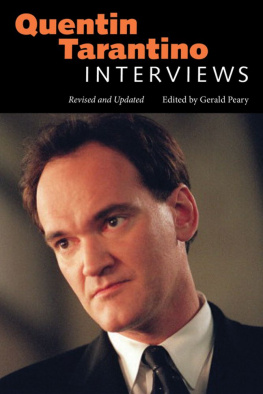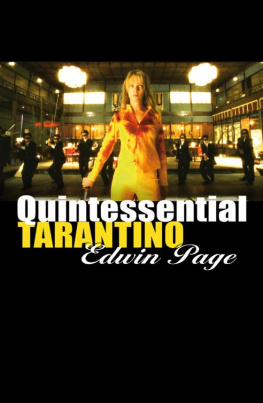12400 Ventura Blvd. #1111
Cover design by Johnny Ink. www.johnnyink.com
All rights reserved. No part of this book may be reproduced in any form or by any means without permission in writing from the author, except for the inclusion of brief quotations in a review.
Kenworthy, Christopher.
Shoot like Tarantino : the visual secrets of dangerous directing / Christopher Kenworthy.
1. Tarantino, Quentin--Criticism and interpretation. 2. Cinematography. 3. Motion pictures--Production and direction. I. Title.
Introduction
Quentin Tarantino is a master of tension, suspense, shock moments, dazzling dialogue scenes, and offbeat humor. This book shows you why the best moments in his films work so well, and how you can take that knowledge to make your own films work more effectively.
You dont want to copy Tarantino. Hundreds of people copy Tarantino without understanding what it is that makes him brilliant and the result is usually a lot of swearing and pointless violence. When people copy Tarantino badly it makes for an embarrassing mess.
You want to be an exciting and original filmmaker, but when you learn the shots, shortcuts, and creative setups that Tarantino has mastered, you will become a better filmmaker. An understanding of how he works should give you more opportunities to be creative with the camera.
A huge part of Tarantinos storytelling comes from his screenwriting and the way he directs actors, but he has such an advanced understanding of screen language that hes able to tell stories more efficiently than most directors. The films explored in this book show that no matter how good your actors or your script, you need to explore the magic of the camera to make your story work on the big screen.
The scenes chosen for this book range from unforgettable masterpieces to more functional moments, to show that a good storyteller must make the most of the shot, whether its the best scene or one of the minor plot points. One of Tarantinos strengths is his efficiency. He proves that you barely need to move the camera to tell a good story. He also shows that every moment counts, and far from being a director who lets scenes drift on for no reason, he guarantees there is a point to everything you get to see.
The chapters in this book will teach you skills that you can apply to your own films, making them a part of your own style. When writing this book I made a point of studying how the scenes work, rather than reading any background information. I didnt want to know any theories or legends regarding scenes. For you to get the most from this book, you need to know the exact technical reasons that these scenes work. The important point here is that no matter how creative or wild you want to be, you need to be a technician to tell stories well.
Tarantino is famous for many reasons, but he is underrated as a technical filmmaker. This book illuminates his talent for establishing character and story in seconds, or maintaining tension for unbearable lengths of time. This would not be possible if he was simply covering the scenes in the traditional way, with a master and a few close-ups. His films work because hes found ways to shoot that make the most of every moment.
I hope this book will show you that good filmmakers do more than shoot the scene thats in front of them. There are details in these scenes that show Tarantinos obsession with getting the best possible scene. He cares about film, and he takes the time to make sure that every angle, every glance, every motion and camera move serves the needs of the story.
Tarantino shows that some of the simplest techniques can lead to some of the most sizzling scenes ever shot. When you know how Tarantino creates these tense, dramatic, and shocking scenes, you can adapt the ideas to your own style.
By the time you have reached the end of the book you should have a good grasp of how Tarantino sees a scene, how carefully he sets it up, and how he films creatively. Youll be able to shoot your own scenes with a better understanding of the visual techniques that make a scene come to life.
How to Use This Book
Watch every Tarantino film you can before you read this book and buy copies of the films that you can keep, so you can watch these scenes (and others) to decode the techniques. The chapters are filled with spoilers, so make sure you watch the films first. Most of the scenes are from relatively early on in the film, to avoid giving too much away, but you should still watch each film before reading the book.
You can work through the book in order, pick a chapter that interests you, or work through according to your favorite films.
The techniques can be applied to your own work. If youre creating a scene that needs unbearable tension, theres a chapter dedicated to that and you can go straight there.
Before you read the chapter, watch the scene in question if you can and try to see how and why it works. Then, once youve read the chapter, watch the scene again, perhaps with the sound down so you can focus on the camera moves and see how the scene has been crafted.
Chapter 1
Raising Tension:
Inglourious Basterds



